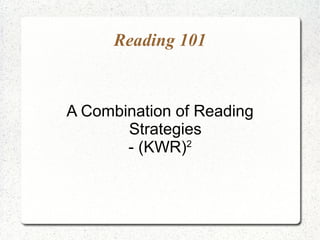
Reading 101: The Powerful (KWR)2 Reading Strategy
- 1. Reading 101 A Combination of Reading Strategies - (KWR)2
- 2. Learning Objectives To synthesise different reading strategies into one powerful and effective strategy To apply this strategy to greatly increase the understanding of a text
- 3. Introduction Any good comprehension strategy has a common point. It must help you to make sense of the text easier, faster and better. There are many reading strategies available. Let's look at some of them and see how many you are already applying in your interpretation of passages.
- 4. Common Reading Strategies Do you use these strategies in a single text? 1) Rereading 2) Stopping to think 3) Getting a mental image 4) Understanding why you are reading 5) Reading ahead 6) Connecting to your own knowledge 7) Making predictions 8) Drawing inferences
- 5. One Strategy What if you have a strategy to combine all? This strategy must be able to help you: 1. Visualise – to get a picture image 2. Gain knowledge – grasp the facts 3. Retell – test understanding 4. Question – probe for deeper meaning 5. Connect the dots – activate your own knowledge of the topic discussed Q: Why are all these reading outcomes critical?
- 6. One Strategy This one strategy must above all, help you to make sense of the text faster, better and easier. Combing all the benefits of the different strategies, a strategy has been developed. Called (KWR)2 , it is described as follows: 1) KW - Key Words of Text and Question 2) R – Read for gist for Nouns, Verbs, Adj. & Adv. 3) KW – Write what you know and wish to know 4) R – Read for details and build up you KW list
- 7. KW in (KWR)2 introduced KWs or Key Words cover the key ideas in the questions and text, providing you with a visual. In the question below, the KWs are underlined: Q1: When did the girl realise that she was lost in the woods? Q2: Why did the girl climb the tree quickly when she saw the tiger? When – girl – realise – lost – woods? Why – girl – climb – tree quickly – saw – tiger? What do the KWs tell you about the story?
- 8. KW in (KWR) explained 2 What do the KW in the questions tell you? Do they give you a sense of the text? Do they give you the key ideas in the questions? Do they help to guide your thinking towards a certain topic the text is talking about? Do they prepare you what's to be read in the text? If your answers to these questions are a resounding 'yes', start highlighting the KW now!
- 9. R in (KWR)2 introduced R means read for gist enables you to gain initial knowledge of the text with the TS and SP for KWs. They are underlined. For the past few months, the British army and navy have been conducting joint exercises in the sultanate of Oman. The operation is called Swift Sword II, and by happy coincidence, it happens to put 23,000 British soldiers in the vicinity of Afghanistan. Many of them are now expecting to take part in the ground war and have been training furiously since Sep 11.
- 10. R in (KWR) explained 2 After reading for gist, what do you think the passage is about? Can you recall the key points of the text?
- 11. 2 KW in (KWR) introduced nd 2 We don't read mindlessly with an empty slate. We visualise the story and connect it with what we know. The passage below is proof.
- 12. 2nd KW in (KWR)2 explained In other words, use what you know to connect with the text to improve comprehension. KW helps you to connect the dots by combing your knowledge and questions with what the writer is telling you. 1) K – requires you to write down what you know 2) W – requires you to ask 5W1H questions about the text. By thinking about the two questions above, you can easily activate your knowledge!
- 13. 2 R in (KWR) introduced nd 2 After visualing, skimming, activating your knowledge and questioning the text, you are now ready to connect all the dots together! Everyone can look, but not everyone can see!
- 14. 2 R in (KWR) introduced nd 2 Can you see the 'real' pictures behind the two pictures? If you know that there are two animals and ladies, can you see fully now?
- 15. 2 R in (KWR) explained nd 2 R requires you to read it again to get full understanding – to connect the remaining dots you have missed to complete the mental picture. This is the time when you should be fully using secondary text gap strategies: 1) Contextual Gap Filling – use contextual clues for difficult words/phrases/parts of the text 2) Answering your questions and clarifying doubts – actively question and answer your own questions about the text.
- 16. Learning Activity Now that you have completed your training on (KWR)2 reading strategy, refer to your Learning Guide for Learning Activity. Recall the steps for (KWR)2: 1) KW – Key Words 2) R – Read for gist 3) KW – Know and what you wish to know 4) R - Reread
- 17. Discussion Why is there a need for strategy in reading? How does (KWR)2 help you in comprehension? List down some of the reading strategies (KWR) 2 have combined in its steps.
- 18. In Summary A strategy is needed to help you read better, faster and easier. A combination of strategies is made possible in (KWR)2. (KWR)2 combines strategies in visualising, skimming, activating, retelling, questioning and rereading to increases understanding.
